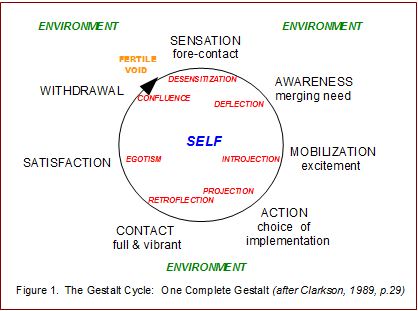Cycle of Experience
TLDR: taking care of unfinished business.
In Gestalt theory, stress and problems with human functioning happen when people get stuck in the various stages, unable to complete their cycle of experience.
A unit of work is a complete experience such as the completion of a task, resolution of a problem or a learning experience. When there is an incomplete unit of work, there is resistance somewhere along this cycle of experience that prevents the work from completing. Energy is released and available for other units of work only when the cycle of experience is complete.
This appears to be related to the needs satisfaction cycle, but it uses slightly different terminology.

We have many needs and cycles of experience going at once, and we can interrupt this cycle, preventing that need from being met. The indented items are resistances happening between each stage of the cycle of experience that prevent us from proceeding further along the cycle.
- Sensation: something figural happens that disturbs the individual from the steady state. E.g, feeling that my throat is dry.
- Desensitization: this happens before reaching awareness. The person who is desensitizing does not even become aware of the need. Often occurs as a result of abuse. E.g, feeling nothing when someone shouts at you.
- Awareness: awareness of sensation causes the need to do something e.g I need a drink of water
- Deflection: excuses that you use to deflect the need, e.g changing topics in a conversation or making a joke
- Mobilization of Energy: committing to satisfying that need and getting ready to take action
- Introjection: all the should nots, excuses and justifications that we use to avoid taking action
- Action: taking an action to satisfy that need
Projection: this happens before reaching contact. Projecting your thoughts onto other people, guessing how they think or feel.
This is also where you try to rescue others by getting them to engage in units of work that you yourself have not completed. For example, the regret from not expressing your feelings for a loved one who passed away causes you to nag others to do so for their own loved ones. The desire to rescue others can be prevented by doing your own self-work to establish healthy boundaries so you know what units of work is yours, and which can only be done by others.
Retroflection: working against our need and redirecting the contact to ourselves instead. E.g, using porn
- Contact: when the need is met
- Egotism: refusing to be satisfied by making it about yourself. e.g i was praised but i resisted the satisfaction by saying they don’t really know what kind of person i am
- Satisfaction: satisfaction that the need is met
- Confluence: your work is done, but because of others, you can’t leave. e.g i’m no longer depressed but my best friend is, i cant say i am not because it will be leaving him
- Withdrawal: letting go for a new sensation to arise
Resistances Are Not Always Negative
Resistances can also be a form of intervention. To end sexual harassment, the would-be perpetrator should use introjection to curb the impulse. To improve mental health, use desensitization and ignore the news.
Some amount of resistances is also normal and healthy. We would be overwhelmed without resistances which prevents us from being able to process too many units of work simultaneously. It is also a critical mechanism for survival and well-being.
Thanks Wynn for this great summary.
References:
- Gestalt Cycle of Experience
- See this video on the cycle of experience. It is slightly different from what is described here.